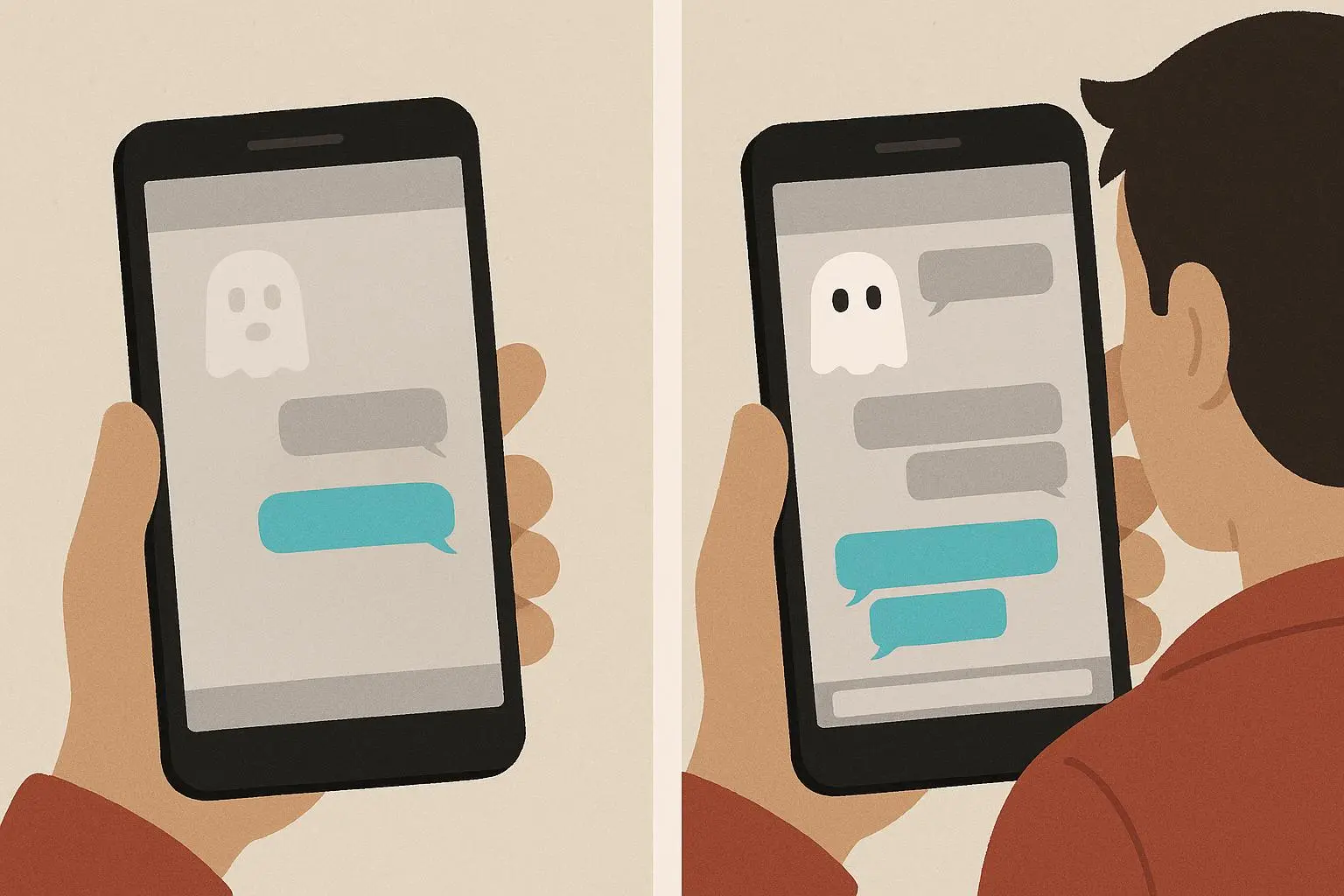
How to Prevent Ghosting: Openers & Follow-Ups That Work
Published on 2/28/2025 • 8 min read
I used to think ghosting was just part of the modern dating economy—the tumble of messages, the brief spike of excitement, and then the inevitable silence. After dozens of matches and tracking outcomes for six months, I learned it's not unavoidable. By changing how I opened conversations and using three consistent follow-up moves, my no-response rate dropped from about 68% to roughly 35%, and I turned chats into in-person dates twice as often.
That change didn't come from a trick or a template alone. It came from treating conversations like small experiments: tweak one variable, observe the outcome, and repeat what works. Below I share the tactics I used, copy-paste templates, and the privacy-minded way to use engagement tools.
Why people ghost (and why it’s not always personal)
Ghosting feels personal, but often it’s about attention, timing, or unclear cues. People swipe through dozens of profiles daily; a vague opener is easy to ignore. Sometimes someone is busy or emotionally unavailable. Other times a conversation stalls because the other person doesn’t feel seen or prompted to reply.
You can’t control someone else’s life, but you can design messages that reduce friction and invite replies. That shift—from hoping to being intentional—is where results come from.
Ghosting is rarely magical—it's predictable. Once you understand the patterns, you can change how you show up.
Make your first impression unforgettable
The first message sets the tone. Treat it like a tiny audition: personal, specific, and easy to reply to. When I started doing this consistently, my reply rate improved measurably—one season I saw replies on 58% of first messages versus 32% with generic openers.
H3: What a strong opener does
- Signals you read their profile.
- Gives a low-effort way in (easy to answer).
- Creates a seed for ongoing conversation.
H3: Copy-paste first-message examples (use as templates)
Curious + specific: “That cliff photo is wild—where was it taken?”
Playful tease tied to a hobby: “You collect vinyl? Bet I can guess your weirdest album—what’s the last record you bought?”
Shared interest prompt: “You said ramen—best bowl in the city? I need a new spot.”
Light challenge: “You’ve traveled a lot—truth or myth: do you always lose luggage?”
Short and sincere: “Your dog is adorable—what’s their name?”
Use the version that fits the profile detail. Specificity beats generic every time.
From small talk to real talk: building rapport
Once the opener lands, move from interesting to relatable. Small talk is a bridge—use it to find a thread you can riff on. Shared experiences, niche interests, or travel mishaps create a conversational groove.
H3: Techniques for faster rapport
- Share a short, self-deprecating anecdote to signal vulnerability.
- Mirror tone: serious back with seriousness; playful back with play.
- Ask curiosity-driven follow-ups that invite stories instead of yes/no answers.
Example: I joked about attempting a Michelin recipe and failing spectacularly. That led to a mutual exchange of kitchen disasters—and a quick segue to meeting to compare notes at a casual food spot.
The art of the follow-up: recognizing fading interest
Conversations usually fade instead of ending abruptly. Watch for signs: shorter replies, longer delays, fewer questions, or replies that don't invite a response.
H3: Three graceful follow-up moves (use these in order)
1) Playful nudge
A light, specific prompt that’s easy to respond to. Example: “I need your expert opinion: pineapple on pizza—culinary crime or underrated delight?”
2) Value-add message
Share something relevant that continues the thread: a playlist, a quick article, or a local recommendation. Example: “You mentioned hiking—here’s a short trail guide I like. Have you been?”
3) Exit with dignity
If energy stays flat after two tries, step back with a brief, friendly sign-off: “I’m having a busy week—if you want to pick this back up later I’d be down. Otherwise, take care!”
Using these intentionally reduced my urge to over-message and recovered several stalled threads.
Tools to remove guesswork: what the detector measures and privacy
If you want objective feedback, use engagement tools carefully. For example, Rizzman’s Dry Text Detector (a hypothetical example) analyzes message patterns to estimate engagement level—metrics like average reply time, change in message length, ratio of questions asked, and whether the other person is initiating new topics.
What it measures:
- Average reply time and reply-length trend.
- Frequency of questions vs. statements.
- Initiation rate (who starts new threads).
Privacy precautions (important):
- Never upload private images or conversations that contain third-party data without consent.
- Prefer anonymized text input or summaries instead of screenshots with identifiable info.
- Use these tools to inform your judgment, not to replace it.
A low-engagement flag is information, not a verdict. Combine tool output with your sense of tone and context.
How to re-engage when interest fades
Timing and tone matter more than cleverness. Wait a day or two after a lull unless the chat had clear momentum. When you follow up, reference something they shared and offer an easy hook.
Copy-paste follow-up examples:
- Reference + simple ask: “I walked past [Shop Name] today and thought of your rec—what’s your go-to order there?”
- Playful reset + meetup: “We clearly disagree on the best taco—want to settle this over a drink Friday?”
- Gentle opt-out prompt: “If now’s not a good time, no worries—tell me when it might work better.”
A specific, low-pressure invitation increases the chance of getting a yes.
Secure the date: turning chats into meetups
Don’t wait too long to suggest meeting. After a few days of good back-and-forth, propose a concrete plan. Specificity removes friction.
H3: How to propose
- Be specific: time, place, and activity. Example: “Want to continue this Saturday at 3pm at [Café Name]?”
- Offer low-pressure options: coffee or a short drink is ideal.
- Confirm kindly the day before: “Looking forward to our coffee tomorrow—see you at 3pm at [Name].”
If they dodge or decline, stay polite and move on. A calm, friendly close preserves dignity and your time.
When to move on (and how to do it gracefully)
If someone repeatedly delays, avoids details, or replies perfunctorily, that pattern matters. Move on without drama.
Examples of graceful closes:
- Short and honest: “I haven’t felt the momentum here—best of luck out there.”
- Light-hearted final nudge: “Bet you can’t beat my weirdest travel story—one last shot?”
Either way, clarity frees you to pursue better-fit connections.
Real-life, quantified examples that changed my approach
Playlist value-add: After sharing a themed five-song playlist with one match, she replied within 6 hours and we met for drinks two weeks later. That method converted stalled threads into dates roughly 1 in 4 times during a three-month stretch.
Wait-and-challenge tactic: I avoided double-texting and instead used a playful challenge two days later. The immediate reply rate on those follow-ups jumped by about 40% compared to impulsive double-texts.
These are small, measurable wins that came from treating conversations like experiments.
Small habits that prevent ghosting
- Read profiles and reference specifics.
- Keep messages short, curious, and open-ended.
- Mirror tone and match energy; escalate playfully when appropriate.
- Make plans while the vibe is good—be decisive and clear.
- Respect your time: step away when energy fades.
Quick mental checklist before sending a follow-up: Am I adding value? Is this easy to reply to? Would I respond to this message if I received it?
Final thoughts: make your moves with intention
You’ll still get ghosted sometimes. But being intentional—crafting memorable openers, building real rapport, recognizing signs of fading interest, and confidently asking for a date—changes the odds. Use objective tools for calibration, protect privacy, and trust the patterns.
If you want to stop guessing: be specific, be interesting, and invite someone into a small, low-pressure experience. The rest is details.
Micro-moment: I remember closing my laptop after a string of dead-end chats, drafting a single, silly follow-up about tacos, and getting an immediate reply that led to a date two days later.
Personal anecdote: I tracked messaging experiments for six months. I logged openers, follow-ups, reply rates, and whether a conversation led to a meetup. Early on I relied on instincts—cute lines and flirty emojis—but the outcomes were noisy. So I changed my process: every first message had to reference something specific from the profile, every follow-up had to be one of the three graceful moves I outline above, and I limited myself to two follow-ups before either proposing a date or stepping back. Over time the patterns became clear: specific openers invited longer replies, value-add follow-ups sparked renewed interest more often than passive double-texts, and clear date proposals converted a predictable share of active threads. The numbers mattered, but the real benefit was less second-guessing. I could try one cleaner approach and move on quickly when it wasn’t working—saving time and avoiding the spiral of over-messaging.
Ready to Optimize Your Dating Profile?
Get the complete step-by-step guide with proven strategies, photo selection tips, and real examples that work.


